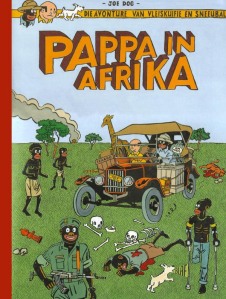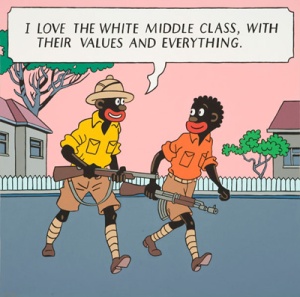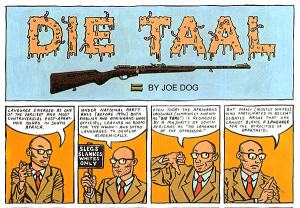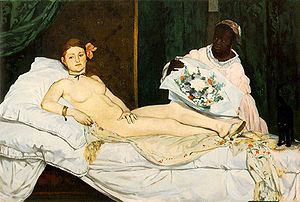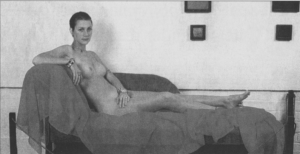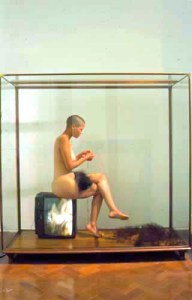There are a number of South African artists whose work comments on apartheid history and its effects on today’s society:
BITTERKOMIX:
Conrad Botes and Anton Kannemeyer, both graphic design students at the University of Stellenbosch in South Africa, have compiled a number of comics to create what is known as Bitterkomix. The artists have taken an alternative route in addressing issues during Apartheid and post-Apartheid by dissecting the masculinity of the white Afrikaner male from the inside in order to examine how these subjects have faltered in South African history. Compiled together, Bitterkomix reveals what many characterize as obscene, violent, and provocative images. The medium they have chosen is effective and uses popular culture to reach out to South African society by confronting today’s characteristics and how South Africa’s politics have dealt with recent history.
Anton Kannemeyer explains; “Most of the strips are aimed at subverting the values that we grew up with.”(Mark Sinclair, 2004). They focus on their examples of life growing up in a Christian Nationalist educational system and being condemned to a militaristic ideology and Dutch Reformed Church. This was the typical lifestyle that the white Afrikaner adolescence experienced. Some examples of main characters seen throughout their comic strips have shown to be corrupt schoolteachers, dishonest policemen, alcoholic men, misogynists, homophobes and the father figure. Most pages of Bitterkomix express these men as un-heroic and driven by violence and sex. They show masculinity as being unstable and weak, which is not a typical characteristic an Afrikaner man would typically broadcast (Jeanne Van Eeden, 2005).
Bitterkomix differs from other artists who bring up themes of Apartheid because instead of focusing on the oppression and finding ways to disconnect from it, Bitterkomix addresses the corrupt beliefs of the Afrikaner without any sort of political agenda ( Rita Barnard, 2004). Instead, they are more about exploring this type of character at it’s weakest. Though both artists are criticized for exclusively focusing on the faults of the Afrikaner, the works are very helpful for the younger generation Afrikaner who is experiencing anxieties about his/her identity in a new and totally reformed South Africa. Reading and being exposed to Bitterkomix welcome these young Afrikaners to have a criticized view on their Afrikaner patriarchy that they have alienated (Rita Barnard, 2004).
http://www.stripkap.net/sa2.html
PERFORMANCE ART
Performance art is considered a broad category because many diverse styles fit loosely under the term “performance.” In performance art, the artist displays themselves as both the subject as well as the object. This alternative art medium is live and temporary, so there are few people who get to experience the art. It is an art medium in which viewers are provoked to think about what the human body is, what it stands for, how it is presented, and how it is seen (MacKenny; 2001).
Performance art is seen more through women artists than the male artist because feminists use art to speak their concerns on many gender issues and they tend to choose this medium because the world of painting and sculpture has always been male-dominated in art history. Women took over performance art in search of finding their niche in the art world. Cheri Gaulke’s words represent the general views felt by feminist artists, “in performance we found an art form that was young, without the tradition of painting or sculpture- without the traditions governed by man.” (Goldberg; 1998).
EXPOSED – Carol-anne Gainer
Carol-anne Gainer’s performance piece goes along with Manet’s Olympia. Olympia comments on the imbalance of power with regards to race. In Manet’s piece we have a black woman serving the white, which is very pertinent and apparent in South African culture. Gainer, a white South African female, poses in a museum setting. The point she is trying to get across is simply that when a black woman is not placed near her, the image or performance becomes a neutral one. Whiteness is invisible when not paired with the black servant. She is commenting on race and power identity (MacKenny, 2001).
Manet’s Olympia
Gainer’s Ex-Posed performance piece
http://www.carolannegainer.com
SPAN II – Tracey Rose
From as early as 1904, The South African political system was divided into four racial groups. Black, white, Indian, coloured and ‘other.’ The term ‘coloured’ is still used today and is loosely defined as a person having a percentage of whiteness. There was the pencil test, which was used by government officials in order to capture your identity on paper because people’s roots were very unclear.
THE TEST: Authorities stuck a pencil in one’s hair. If it stuck, you are African. If it fell out, you are coloured.
Tracey Rose’s performance piece involves this issue of identity. Having shaved all of her hair off, she sits in a glass case in the museum tying each strand of hair with one another. Because your hair defined whether you were African or coloured, you hair either puts you higher up in the hierarchical scale or lower. (coloured people are treated better because they have a percentage of whiteness in them).
Tracey Rose, Span II, preformaed at South African National Gallery
http://www.artthrob.co.za/01mar/artbio.html
For more art on the apartheid, please visit the Apartheid Museum’s website at: http://www.apartheidmuseum.org/
